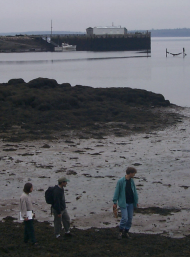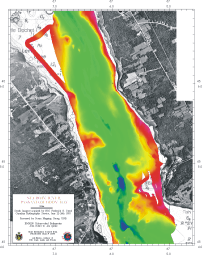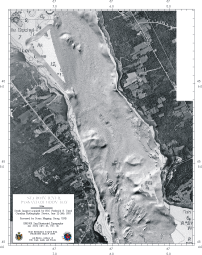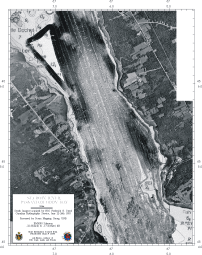Overview
A hydrographic survey was executed in May 1999 as part of SE4083 - Hydrographic
Field Operations. SE4083 is a 4th year undergraduate course offered within
the Dept. of Geodesy and Geomatics Engineering at UNB as part of the specialisation
in Ocean Mapping. The aim of the course is to expose the students to the
practical issues involved in the planning, execution and processing involved
in a coastal marine survey.
The area chosen for the 1999 course was the St. Croix Estuary,
which extends from St. Stephen to St Andrews, New Brunswick, where the
estuary merges with Passamaquoddy Bay.
the above images are of a Simrad EM1000 multibeam
survey of the lower St. Croix Extuary, conducted in 1995 by the CSS Frederick
G. Creed
The field program was done in partnership with the Hydrographic
Cooperative (HyCoop) program of the U.S. Naval Oceanographic Office. The
HyCoop program provided a RESON Seabat 9001 multibeam sonar together with
peripheral hardware (TSS-335B, and gyro-compass). By working with the HyCoop
personnel we were able to gain access y working with the HyCoop
personnel we were able to gain access both to their advanced hardware and
the practical experience of their staff. This proved to be particularily
valuable for our students.
| The main survey platform is the RV Mary-O, a 41ft coastal research
and teaching platform, owned and operated by UNBSJ. The vessel
has a dedicated 110V generator with an uninterruptable power supply.
It can comfortably take 4 personnel inside during survey operations. For
teaching purposes, up to 10 can be accomodated internally. The Mary-O
is based at Deer Island, New Brunswick and is available year-round for
undergraduate and graduate research and training. |
 |
 |
On the starboard side of the Mary-O a custom swinging mount has been
built (to a RESON design) which is capable of deploying a variety of sonar
instrumentation at a depth of ~1m. The mount has been successfully used
at speeds up to ~ 8 knots, although 5-6 knots is a typical operational
speed.
All survey operations were conducted from the St.Andrews Biological
Station dock in Brandy Cove. |
 |
For the first two weeks of operation, a RESON Seabat 9001 sonar
was installed. For the deep water operational area, it was mounted symetrically
to provide coverage for a +/- 45 degree sector. The 9001 uses amplitude
detection only for all 60 beams . Each beam is 1.5 by 15 degrees. The ping
rate depends on the operator range setting, and for the water depths encountered
was always at least 10Hz. |
 |
 |
For the intertidal operations, the 2x WD coverage would have been prohibitively
expensive in ship time (requiring line spacings of a few metres. Therefore,
the sonar head was mounted to mimic one half of a RESON Seabat 9002 configuration,
in which each head is tilted 30 degrees. In this case we now had only 15
degree coverage to port, but 75 degree coverage to starboard. This provided
a more than twice as wide swath. However, because the sonar only performs
amplitude detection, the quality of the bathymetry at low grazing angles
was notably degraded. |
| The RESON Seabat 9001 was integrated with a TSS-335B motion sensor
and a gyro compass provided by HyCoop. UNB provided the Ashtech Z12
DGPS receivers. Line running was performed using HyPack and data collection
used the RESON 6042 V.5 software. All post processing was done using the
OMG/UNB SwathEd software. |
 |
 |
For the last week of the survey, a Submetrix 2000 was kindly loaned
by Submetrix U.K. Is was being used as a demonstration for the USGS and
a U.S. NRL lab. The students had the opportunity to install, align and
operate this system although no significant processing of the data was
done for time reasons. |
| Horizontal and Vertical control was established from New Brunswick
and Canadian Hydrographic Service monumentation |
 |
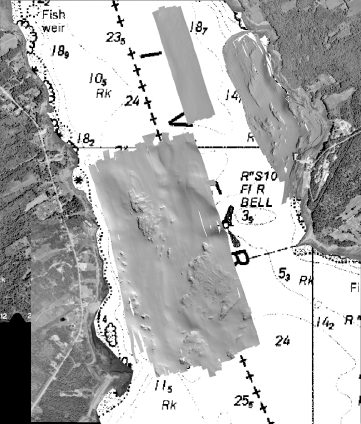 |
Area of Interest
The area of interest was the seabed in the vicof interest was the seabed in the vicinity of the St. Andrews
Biological Station dock. The area was chosen based on practical considerations
such as:
-
proximity to cheap accomodation and laboratories (at the Huntsman Marine
Science Centre)
-
availability of SABS dock (secure in most weather condtions, with control
and tide gauge mount)
-
pre-existing swath survey data in area
-
macro tidal regime
-
national boundary
Three main surveys were conducted:
-
deep subtidal site (20-40m) over the international boundary.
-
inshore shallow subtidal and intertidal site
-
flat featureless area for patch test calibrations.
|
Oceanographic Framework of the St. Croix Estuary
The St. Croix Estuary extends from the Hydroelectric dam just
upstream of St. Stephen, 15 miles south to St. Andrews where it flowiles south to St. Andrews where it flows into
Western Bay and Passamquoddy Bay. The region is one of high (6-8m) tides.
The St. Croix River drains southern Maine. Whilst it does input fresh water,
no noticeable stratification was observed from any of the TS profiling
performed as part of this operation.
For almost all profiles collected in May 1999, the sound speed varied
less than 1m/s from top to bottom. Inital profiles were made using the
UNBSJ manual sensor. Later measurements were made using the CHS AML SVP-16.
Prior Surveys
1992 HYGRO 92 Creed EM1000 transits
1995 Creed EM1000 Dochet to St. Andrews and Western Bay
1996 EM3000 St. Andrews Harbour
1997 EM3000 Huntsman foreshore
1996 and 1997 USCHC comparison systems
Deep Water Survey Area
Intertidal Survey Area
| A survey was conducted ranging from 15 depth below chart datum to ~5m
elevation above chart datum. The survey demonstrated the complications
of trying to maintain 100% coverage in variable and declining water depths.
The area coveraged included the shallow subtidal area investigated in 1997. |
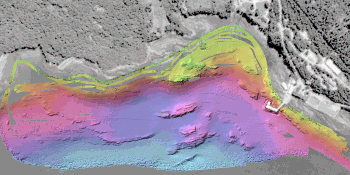 |
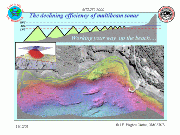 |
In order to demonstrate the declining efficiency of multibeam sonar
in shallow water, an attempt was made to utilise the RESON multibeam in
two differing mount configurations in the intertidal zone. By using the
tides, one could operate the system with 6-7m of water over chart datum. |
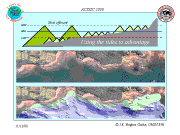 |
 |
In this manner, swath data could be collected in areas where the students
could subsequently walk and exami
could subsequently walk and examine and compare the visible seabed features
with the representation obtained by multibeam sonar. The elevation of floating
algae and the height of proud features were surveyed using conventional
and RTK GPS methods. |
 |
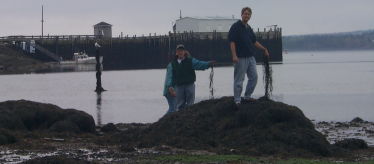
SABS aquarium seawater intake pipe (and associated concrete blocks)
A serendipitous find as part of this survey, was the presence of a line
of concrete blocks that hold down the intake pipe, delivering seawter to
the research aquariums at the St. Andrews Biological Station. The target
detection capability of the RESON 9001 is +/-45 degree and -15+75 degree
mode was compared. THe results from the Submetric 2000 were also examined.
Later that year a RESON Seaabt 8101 (loaned courtesy of Fugro Jacques Geosurveys)
was also deployed on those targets.
Personnel
Instructors:
-
John E. Hughes Clarke
-
Dave Wells
-
Dave Wells
Technical Support:
-
Martin Leese
-
Howard Biggar
Teaching Assistant:
UNB students:
-
Heather Langill
-
Jamieson Murphy .....
-
Graham Nickerson
-
Arne Hoof
-
Frank Backes
-
Shawn MacFarlane
NavO, HyCoop staff
-
Kevin Thrash
-
James Causey
-
Skip Denny
-
Jimmy Villareal
Other Visitors
USGS; Bill Danforth and Tommy O'Brien.
Submetrix: Paul Byham
CHS -Quebec: Andre Godin and Louis Maltais
NRL Arctic Lab:.
last modified 12th November 2000 by John
E. Hughes Clarke.
